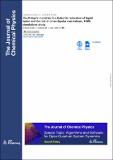Por favor, use este identificador para citar o enlazar a este item:
http://hdl.handle.net/10261/343032COMPARTIR / EXPORTAR:
 SHARE SHARE
 CORE
BASE CORE
BASE
|
|
| Visualizar otros formatos: MARC | Dublin Core | RDF | ORE | MODS | METS | DIDL | DATACITE | |

| Título: | The Debye’s model for the dielectric relaxation of liquid water and the role of cross-dipolar correlations. A MD-simulations study |
Autor: | Álvarez González, Fernando CSIC ORCID; Arbe, Arantxa CSIC ORCID; Colmenero de León, Juan CSIC ORCID | Fecha de publicación: | 2023 | Editor: | American Institute of Physics | Citación: | Journal of Chemical Physics 159(13): 134505 (2023) | Resumen: | By means of massive (more than 1.2 · 106 molecules) molecular dynamics simulations at 300 K we have disentangled self- and cross-dipolar contributions to the dielectric relaxation of liquid water that cannot be experimentally resolved. We have demonstrated that cross dipolar correlations are of paramount importance. They amount for almost a 60% of the total dielectric amplitude. The corresponding relaxation function is a one-step Debye-like function with a characteristic time, τcross, of the order of the phenomenological Debye time, τD. In contrast, the relaxation function corresponding to the self-contribution is rather complex and contains a fast decay related to dipolar librations and a second relaxation step that can be well described by two exponentials: a low-amplitude fast process (τ0 = 0.31 ps) and a main slow process (τself = 5.4 ps) that fully randomizes the dipolar orientation. In addition to dipolar relaxation functions, we have also calculated scattering-like magnitudes characterizing translation and rotation of water molecules. Although these processes can be considered as "jump" processes in the short time range, at the time scale of about τD-τcross, at which the cross-dipolar correlations decay to zero, the observed behavior cannot be distinguished from that corresponding to uncoupled Brownian translational and rotational diffusion. We propose that this is the reason why the Debye model, which does not consider intermolecular dipolar interactions, seems to work at time t ≳ τD. | Versión del editor: | https://doi.org/10.1063/5.0168588 | URI: | http://hdl.handle.net/10261/343032 | DOI: | 10.1063/5.0168588 | ISSN: | 1089-7690 |
| Aparece en las colecciones: | (CFM) Artículos |
Ficheros en este ítem:
| Fichero | Descripción | Tamaño | Formato | |
|---|---|---|---|---|
| debyestudy.pdf | 4,48 MB | Adobe PDF |  Visualizar/Abrir |
CORE Recommender
SCOPUSTM
Citations
1
checked on 02-may-2024
Page view(s)
11
checked on 06-may-2024
Download(s)
4
checked on 06-may-2024
Google ScholarTM
Check
Altmetric
Altmetric
Este item está licenciado bajo una Licencia Creative Commons

